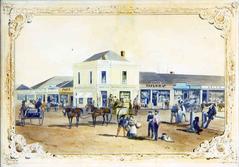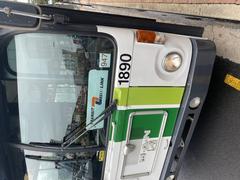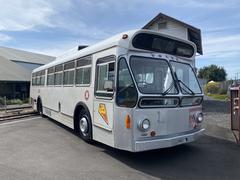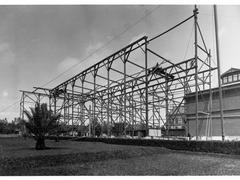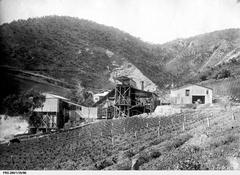Cleland Wildlife Park Visiting Guide: Hours, Tickets, and Tips
Date: 23/07/2024
Introduction
Nestled in the scenic Adelaide Hills of South Australia, Cleland Wildlife Park offers an unparalleled opportunity for nature enthusiasts to immerse themselves in the diverse flora and fauna native to Australia. Established in 1967 as part of the Cleland Conservation Park, the park was named after Sir John Burton Cleland, a distinguished Australian naturalist and microbiologist (Cleland Wildlife Park). The primary mission of the park has always been to provide a sanctuary for native wildlife and to offer visitors a chance to observe and interact with these animals in a naturalistic setting. Over the years, Cleland Wildlife Park has expanded its reach and impact through robust conservation efforts, educational programs, and community engagement initiatives.
The park is not just a haven for wildlife but also a hub for scientific research and conservation. It plays a critical role in the preservation of endangered species like the Southern Brown Bandicoot and the Yellow-footed Rock-wallaby through successful breeding programs and national recovery initiatives (Cleland Wildlife Park Conservation). The park’s educational programs are designed to raise awareness about environmental sustainability and wildlife conservation, making it a vital resource for schools and educational institutions (Cleland Wildlife Park Education).
Culturally, the park holds significant importance for the local Kaurna people, the traditional custodians of the land. Their cultural heritage is intricately woven into the park’s identity, offering visitors a chance to learn about the Kaurna people’s traditional practices and their deep spiritual connection to the land (Kaurna Cultural Heritage). Whether you are keen on experiencing close encounters with animals like koalas and kangaroos or interested in exploring extensive walking trails, Cleland Wildlife Park promises a memorable and educational experience for all visitors.
Table of Contents
- Introduction
- Establishment and Early Years
- Conservation Efforts
- Educational Programs
- Cultural Significance
- Visitor Experience
- Visiting Hours and Tickets
- Accessibility
- Research and Scientific Contributions
- Community Engagement
- Economic Impact
- Future Directions
- Nearby Attractions
- FAQ
- Conclusion
Establishment and Early Years
Cleland Wildlife Park, located in the Adelaide Hills of South Australia, was officially opened to the public in 1967. The park was established as part of the Cleland Conservation Park, which was named after Sir John Burton Cleland, a prominent Australian naturalist and microbiologist. The primary aim of the park was to provide a sanctuary for native Australian wildlife and to offer visitors an opportunity to observe and interact with these animals in a naturalistic setting.
Conservation Efforts
From its inception, Cleland Wildlife Park has been at the forefront of wildlife conservation. The park plays a crucial role in the preservation of endangered species, such as the Southern Brown Bandicoot and the Yellow-footed Rock-wallaby. The park’s breeding programs have been instrumental in increasing the population of these species, which are native to South Australia. Additionally, Cleland Wildlife Park collaborates with various conservation organizations and participates in national recovery programs aimed at protecting Australia’s unique biodiversity (Cleland Wildlife Park Conservation).
Educational Programs
Cleland Wildlife Park has a strong focus on education, offering a range of programs designed to raise awareness about wildlife conservation and environmental sustainability. The park’s educational initiatives include guided tours, interactive exhibits, and school programs that cater to students of all ages. These programs are designed to provide visitors with a deeper understanding of the ecological significance of native Australian species and the importance of preserving their habitats (Cleland Wildlife Park Education).
Cultural Significance
The park holds cultural significance for the local Kaurna people, the traditional custodians of the land on which Cleland Wildlife Park is situated. The Kaurna people have a deep spiritual connection to the land and its wildlife, and their cultural heritage is an integral part of the park’s identity. Cleland Wildlife Park acknowledges this connection by incorporating Indigenous knowledge and perspectives into its educational programs and interpretive displays. Visitors have the opportunity to learn about the Kaurna people’s traditional practices and their relationship with the natural environment (Kaurna Cultural Heritage).
Visitor Experience
Cleland Wildlife Park offers a unique and immersive visitor experience, allowing guests to get up close and personal with a wide variety of native Australian animals. The park is home to over 130 species, including kangaroos, koalas, wombats, and echidnas. One of the park’s most popular attractions is the Koala Close-up experience, where visitors can hold and photograph koalas under the supervision of trained staff. Additionally, the park features extensive walking trails, picnic areas, and interactive exhibits that provide a comprehensive understanding of Australia’s diverse wildlife (Cleland Wildlife Park Visitor Experience).
Animal Encounters
Cleland Wildlife Park offers a variety of animal encounters that allow visitors to get up close and personal with Australia’s unique wildlife. One of the most popular experiences is the Koala Hold. Visitors can hold a koala and have their photo taken, creating a memorable keepsake. This experience is available daily, but it is advisable to book in advance due to its popularity (Cleland Wildlife Park).
Another highlight is the Reptile Experience, where guests can interact with various reptiles, including snakes and lizards. This encounter provides an educational insight into these often misunderstood creatures. The park also offers Dingo Walks, where visitors can take a stroll with a dingo and learn about their behavior and conservation status.
Feeding Experiences
Feeding the animals is a significant part of the Cleland Wildlife Park experience. Visitors can purchase animal food from the park and hand-feed kangaroos, wallabies, and emus. This interactive activity is not only fun but also educational, as it allows guests to learn about the animals’ diets and behaviors.
The park also offers Pelican Feeding sessions, where visitors can watch the pelicans being fed while learning about their habits and natural history. These sessions are scheduled daily and are a favorite among both children and adults.
Guided Tours
Cleland Wildlife Park provides several guided tours that enhance the visitor experience. The Cleland Night Walk is a unique tour that allows guests to explore the park after dark. This tour offers a different perspective on the park’s nocturnal animals, such as possums, owls, and bats. The night walk is an excellent opportunity to see these creatures in their natural habitat and learn about their nighttime behaviors.
The Behind the Scenes Tour is another popular option. This tour gives visitors a glimpse into the daily operations of the park, including animal care and conservation efforts. Participants can meet the keepers and learn about the challenges and rewards of working with wildlife.
Walking Trails
The park features several walking trails that allow visitors to explore the natural beauty of the area. The Waterfall Gully to Mount Lofty Summit Trail is a popular choice, offering stunning views and a chance to see native flora and fauna. This trail is moderately challenging and takes about 2-3 hours to complete.
For those looking for a shorter walk, the Cleland Wildlife Park Loop is an excellent option. This easy trail takes about 30 minutes to complete and offers a chance to see a variety of animals and plants. The loop is well-marked and suitable for all ages and fitness levels.
Picnic and BBQ Areas
Cleland Wildlife Park provides several picnic and BBQ areas for visitors to enjoy. These areas are equipped with tables, benches, and BBQ facilities, making them perfect for a family outing or a group gathering. The picnic areas are located in scenic spots throughout the park, offering beautiful views and a chance to relax and unwind.
Special Events
Throughout the year, Cleland Wildlife Park hosts a variety of special events. These events include Wildlife Photography Workshops, where participants can learn how to capture stunning images of the park’s animals. The workshops are led by professional photographers and are suitable for all skill levels.
The park also hosts Seasonal Festivals, such as the Spring Festival and the Summer Wildlife Festival. These events feature special activities, live music, and food stalls, creating a festive atmosphere for visitors to enjoy.
Visiting Hours and Tickets
Cleland Wildlife Park is open daily from 9:30 AM to 5:00 PM, except on Christmas Day and days of catastrophic fire danger. General admission tickets are priced as follows:
- Adults: $30
- Children (4-15 years): $15
- Family (2 adults and 2 children): $75
- Concession: $25
Tickets can be purchased online or at the park entrance. For more information on ticket prices and special offers, visit the Cleland Wildlife Park Tickets page.
Accessibility
Cleland Wildlife Park is committed to providing an inclusive experience for all visitors. The park offers wheelchair-accessible paths and facilities, ensuring that everyone can enjoy the attractions and experiences. Additionally, the park provides sensory-friendly maps and resources for visitors with sensory sensitivities, making it easier for them to navigate and enjoy the park.
Research and Scientific Contributions
Cleland Wildlife Park is also a hub for scientific research, contributing valuable data and insights to the field of wildlife biology and conservation. The park collaborates with universities and research institutions to conduct studies on animal behavior, ecology, and genetics. These research efforts have led to significant advancements in the understanding of native Australian species and their conservation needs. The park’s commitment to scientific research underscores its role as a leader in wildlife conservation and environmental stewardship (Cleland Wildlife Park Research).
Community Engagement
Community engagement is a key aspect of Cleland Wildlife Park’s mission. The park hosts a variety of events and activities throughout the year, including wildlife encounters, workshops, and volunteer programs. These initiatives are designed to foster a sense of community and encourage public participation in conservation efforts. By engaging with the local community, Cleland Wildlife Park aims to inspire a collective commitment to preserving Australia’s natural heritage for future generations (Cleland Wildlife Park Community Engagement).
Economic Impact
Cleland Wildlife Park also plays a significant role in the local economy, attracting thousands of visitors each year and generating revenue for the region. The park’s popularity as a tourist destination has a positive impact on local businesses, including hotels, restaurants, and retail establishments. Additionally, the park provides employment opportunities for the local community, contributing to the economic well-being of the Adelaide Hills region (Cleland Wildlife Park Economic Impact).
Future Directions
Looking ahead, Cleland Wildlife Park is committed to expanding its conservation and educational initiatives. The park plans to enhance its facilities and develop new programs that address emerging environmental challenges, such as climate change and habitat loss. By continuing to innovate and adapt, Cleland Wildlife Park aims to remain a leader in wildlife conservation and a cherished destination for visitors from around the world (Cleland Wildlife Park Future Directions).
Nearby Attractions
The park is conveniently located near several other attractions in the Adelaide Hills, including Mount Lofty Botanic Garden and the Mount Lofty Summit. The park is accessible by car, with ample parking available on-site. Public transport options include buses that run from Adelaide city center to the park. For detailed travel information, visit the Cleland Wildlife Park Accessibility page.
FAQ
Q: What are the Cleland Wildlife Park visiting hours?
A: The park is open daily from 9:30 AM to 5:00 PM, except on Christmas Day and days of catastrophic fire danger.
Q: How much are the tickets for Cleland Wildlife Park?
A: General admission tickets are priced at $30 for adults, $15 for children (4-15 years), $75 for a family (2 adults and 2 children), and $25 for concession.
Q: Is Cleland Wildlife Park accessible by public transport?
A: Yes, buses run from Adelaide city center to the park. For detailed travel information, visit the Cleland Wildlife Park Accessibility page.
Conclusion
In conclusion, Cleland Wildlife Park stands as a testament to the harmonious coexistence of humans and nature. From its humble beginnings in 1967, the park has grown to become a cornerstone of wildlife conservation and education in South Australia. Its ongoing efforts to preserve endangered species, coupled with a strong focus on community engagement and scientific research, underscore its commitment to safeguarding Australia’s unique biodiversity for future generations (Cleland Wildlife Park Research). Visitors to the park are offered a rare opportunity to connect with native Australian wildlife in an immersive and educational setting, enriched by the cultural heritage of the Kaurna people.
The park’s extensive visitor amenities, including animal encounters, guided tours, and picnic areas, ensure that there is something for everyone to enjoy. Furthermore, its significant role in the local economy and its various community initiatives highlight its broader impact beyond the realm of conservation (Cleland Wildlife Park Economic Impact). As Cleland Wildlife Park continues to evolve and adapt to emerging environmental challenges, it remains a cherished destination for both locals and tourists, offering invaluable insights into the natural world. Plan your visit today to experience the wonders of Cleland Wildlife Park firsthand, and stay connected by following their social media channels for the latest updates and events.
References
- Explore Cleland Wildlife Park - History, Visiting Hours, Tickets, and More, 2023, Cleland Wildlife Park source
- Cleland Wildlife Park - A Guide to Animal Encounters, Tickets, and Visiting Hours, 2023, Cleland Wildlife Park source
- Cleland Wildlife Park - Visiting Hours, Tickets, and Essential Visitor Tips, 2023, Cleland Wildlife Park source


